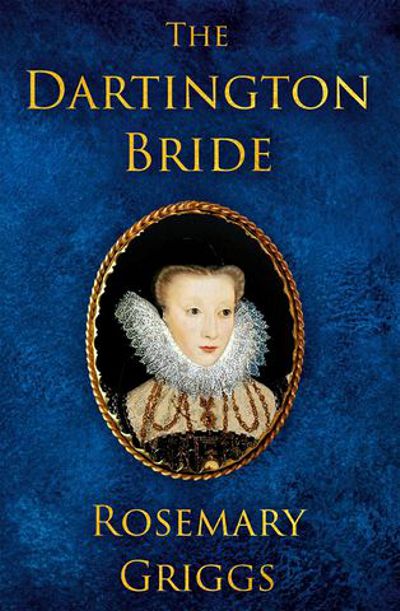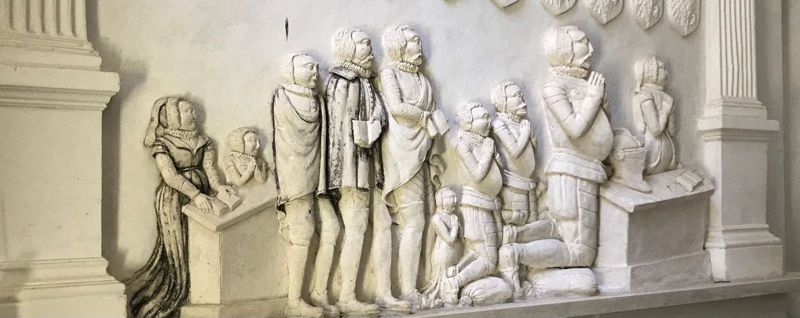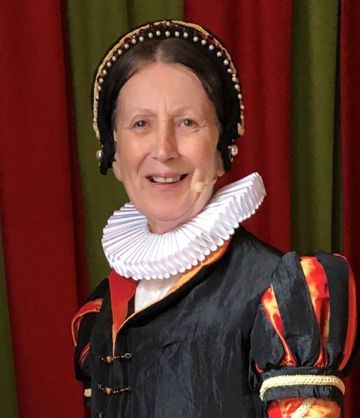
1571, and the beautiful, headstrong daughter of a French Count marries the son of the Vice Admiral of the Fleet of the West in Queen Elizabeth’s chapel at Greenwich. It sounds like a marriage made in heaven…
Roberda’s father, the Count of Montgomery, is a prominent Huguenot leader in the French Wars of Religion. When her formidable mother follows him into battle, she takes all her children with her.
After a traumatic childhood in war-torn France, Roberda arrives in England full of hope for her wedding. But her ambitious bridegroom, Gawen, has little interest in taking a wife.
Received with suspicion by the servants at her new home, Dartington Hall in Devon, Roberda works hard to prove herself as mistress of the household and to be a good wife. But there are some who will never accept her as a true daughter of Devon.
After the St Bartholomew’s Day Massacre, Gawen’s father welcomes Roberda’s family to Dartington as refugees. Compassionate Roberda is determined to help other French women left destitute by the wars. But her husband does not approve. Their differences will set them on an extraordinary path…

The St Bartholomew’s Day Massacre
On 2 September 1572, Sir Francis Walsingham, Ambassador to the French Court, wrote a letter from Paris to Sir Thomas Smith, Secretary of State. Although much of the letter was couched in the usual diplomatic terms, Walsingham shows his anger in one passage. He was incensed that three English subjects had been murdered during the appalling violence that raged through Paris on St Bartholomew’s Day.
Walsingham penned the letter the day following his meeting with King Charles IX. According to the king, his soldiers carried out the assassination of Admiral Coligny, a prominent Huguenot leader, and many other Protestant leaders in order to suppress a potential uprising allegedly led by the Admiral. The attack the king had sanctioned on the Huguenot leaders ignited an explosion of violence on the streets that would persist for several days, leaving around 3,000 dead.

A week before Walsingham picked up his quill pen, in the early hours of 24 August, the massacre began. Most of the citizens of Paris were fervent Catholics. They took the murder of the Huguenot leaders as a signal to attack their Protestant neighbours in the city. Once begun, even royal orders could not bring the mass killing to a halt.
Walsingham seemed to have little faith in the King’s promise that the guilty would be punished, if they could be found. He wrote that he thought it unlikely
‘…the dysorder beinge so generall, the sworde being commytted to the common people’.
Walsingham’s house in Paris was not in the most fashionable part of Paris. He claimed he could not afford a more prestigious address. That may have been a good thing. At least he had time to take in many Englishmen and French Huguenots, to secure the doors and try to protect them from the unprecedented violence that swept through the city. Within the confines of his house in Saint Marceau, Walsingham had his five-year-old daughter, Frances, and his pregnant wife, Ursula. The experience must have been terrifying, as they huddled together behind barred doors, praying that the angry mob would not break in.

The background to the atrocity in Paris lies in the French Wars of Religion that started in 1562. Times of uneasy truce interrupted periods of fierce fighting, with neither side gaining lasting advantage. In 1570, the treaty of St Germain-en-Laye, started a peaceful pause in the wars that had split the country asunder for a decade. The marriage of Protestant Henry of Navarre to Catholic King Charles’ sister, Marguerite was intended to cement the peace between the two religious factions. After protracted negotiations, the wedding took place on 18 August 1572. Many Huguenots, including noblemen and military leaders, converged on Paris to join in the celebrations.
The presence of so many well-born Protestants in a violently anti-Huguenot Paris created a very tense atmosphere. Despite this, Admiral de Coligny, the Protestant leader, opted to remain in Paris for a few days after the wedding. He had forged somewhat better relations with the young king and hoped to persuade him to send French forces to support William of Orange and those who had risen up against Philip II of Spain in the Spanish Netherlands. Coligny thought that a war against Spain might unite Catholics and Protestants against a common enemy, bringing a reconciliation between the two religious factions.
On the morning of 22 August, as he returned to his lodgings from a counsel meeting, an unknown assailant shot and wounded Coligny. Supporters of the Duc of Guise were believed to occupy the house from which the shot was fired. The Guise family, who were very much opposed to the Flanders war, were popular with the Catholic population of Paris. They also had a long running personal feud with Coligny, who Henry Duc de Guise held responsible for the assassination of his father during the Siege of Orleans in 1563.
The Admiral had escaped serious injury, but many alarmed Huguenot leaders assembled at his house to discuss what had happened. The King visited Coligny, assuring him that they would apprehend those responsible. But during the night of 23 August, the bells of Saint-Germain-l’Auxerrois rang out across Paris. The Admiral was murdered, and his body thrown out of the window of his house. Many Huguenot noblemen were also murdered. That unleashed the mob.
Walsingham’s house did come under attack, the mob only pacified by a Catholic nobleman who summoned the royal troops. Sir Philip Sydney was amongst the English who found refuge in the embassy. Huguenot noblemen, including François de Beauvais, Sieur de Briquemault, whose son had been killed in front of him, also sought shelter there. Briquemault slipped past the royal guards into Walsingham’s house, disguised as a butcher, and hid in the stables. He was discovered a few days later. Despite Walsingham’s pleas for his life, Briquemault was executed for the conspiracy, which he denied to the end
This fascinating period in French and English history is the backdrop for my latest novel, The Dartington Bride. My story concerns Roberda, the daughter of Huguenot military leader, Gabriel, Comte de Montgomery. She leaves her home in France to marry Gawen Champernowne, son of Sir Arthur of Dartington Hall. The events of St Bartholomew’s Day are an important part of Roberda’s story.

Sir Arthur Champernowne came from a very well-connected Devon family. He was a staunch Protestant who supported the French Huguenots’ cause. Appointed Vice-Admiral of the Fleet of the West, a times he co-operated with the privateers of Jeanne d’Albret, Queen of Navarre, against Catholic Spain. In 1568, his nephew, Henry Champernowne of Modbury persuaded Queen Elizabeth to grant permission for him to lead 100 soldiers to fight alongside the Huguenots. After Henry’s death in La Rochelle in 1570, Sir Arthur continued to supply intelligence to Walsingham and Lord Burghley, assisted by his son Gawen.
Sir Arthur travelled to Paris in June 1572 with Sir Henry Middlemore to meet Admiral Coligny to discuss intervention against Spain in the Low Countries. Sir Arthur had returned to Devon before the tragic events of St Bartholomew’s Day. It’s very likely, however, that Gawen remained in France and was in Paris, perhaps hiding in Walsingham’s house, on that August night. Roberda’s father made a dramatic escape, avoiding capture against the odds hotly pursued by the Duc De Guise and his soldiers. They followed him on horseback for miles, before giving up the chase.
Sir Arthur welcomed him and the whole Montgomery family to Dartington Hall as refugees. Soon after they arrived, Sir Arthur wrote to Queen Elizabeth, proposing that an army be raised to relieve the Protestants in France. Two years later his son Gawen, described by John Roberts as an ‘ambitious’ man, joined Roberda’s father in an attempt to relieve La Rochelle, where many Huguenots were resisting royal forces. The attempt was a complete failure.
Scarred by her own experience as a child during the Wars of Religion, Roberda is determined to help others whose lives have been blighted by conflict. But her husband does not approve. Her life as a French woman in a strange land will not always be easy.
Notes:
1: Details of Walsingham’s letter are included in an excellent post in the British Library Medieval Manuscripts Blog: https://blogs.bl.uk/digitisedmanuscripts/2022/08/massacre-on-the-streets-of-paris.html
2: Elizabeth’s French Wars, 1562-1598, William A Heap, p57
3: Devon and The Spanish Armada, John Roberts, p167
Universal Buy Link: https://rosemarygriggs.co.uk/books/2/The%20Dartington%20Bride/
Meet Rosemary Griggs

Author and speaker Rosemary Griggs has been researching Devon’s sixteenth-century history for years. She has discovered a cast of fascinating characters and an intriguing network of families whose influence stretched far beyond the West Country and loves telling the stories of the forgotten women of history – the women beyond the royal court; wives, sisters, daughters and mothers who played their part during those tumultuous Tudor years: the Daughters of Devon.
Her novel A Woman of Noble Wit tells the story of Katherine Champernowne, Sir Walter Raleigh’s mother, and features many of the county’s well-loved places.
Rosemary creates and wears sixteenth-century clothing, a passion which complements her love for bringing the past to life through a unique blend of theatre, history and re-enactment. Her appearances and talks for museums and community groups all over the West Country draw on her extensive research into sixteenth-century Devon, Tudor life and Tudor dress, particularly Elizabethan.
Out of costume, Rosemary leads heritage tours of the gardens at Dartington Hall, a fourteenth-century manor house and now a visitor destination and charity supporting learning in arts, ecology and social justice.
Connect with Rosemary
Website:https://rosemarygriggs.co.uk/
Twitter: https://twitter.com/RAGriggsauthor
Facebook: https://www.facebook.com/ladykatherinesfarthingale
Instagram: https://www.instagram.com/griggs6176/
Threads: https://www.threads.net/@griggs6176
Bluesky: https://bsky.app/profile/ragriggsauthor.bsky.social
Amazon Author Page: https://www.amazon.com/stores/Rosemary-Griggs/author/B09GY6ZSYF
Goodreads: https://www.goodreads.com/author/show/21850977.Rosemary_Griggs
